How extraction systems support global electrification
 The electronics industry continues its exponential global growth, with digital technology reaching into almost every area of industrial and commercial activity.
The electronics industry continues its exponential global growth, with digital technology reaching into almost every area of industrial and commercial activity.
From sophisticated defence systems to household appliances and everything in between, demand for the electronic components that process digital data has never been higher.
Keeping pace with this demand requires investment in automated soldering processes that deliver high quality products at speed, such as PCBs. And that means installing fume extraction systems, such as those produced by Donaldson BOFA, to filter emissions that might otherwise not only present a risk to human health but also contaminate electronic components.
This demand for speed places greater emphasis on automation and the integration of all the constituent parts of the manufacturing process. For extraction systems, this means investing in the technical innovation capable of delivering the airflow management and filtration architecture that can capture emissions effectively and stretch the periods between filter exchanges to minimise downtime and bear down on cost.
This is where Donaldson BOFA’s commitment to research and development really pays dividends, along with its focus on OEM partnerships to deliver the best possible outcomes for end users.
Why an innovative mindset matters in filtration
As Graham Mattok, UK and Ireland Sales Manager for Donaldson BOFA explains:
“We recently dealt with a manufacturer of fire and gas detection equipment, including carbon monoxide monitors, who was concerned about the rate at which they were having to exchange the filters in a non-Donaldson BOFA system.
“An initial investigation quickly identified an opportunity to reduce overall lifecycle costs by moving to technology with larger capacity filters and enhanced airflow. In partnership with our distributor, we came up with a solution by thinking outside the box.”
Further analysis proved that such a change, in this case moving to Donaldson BOFA’s V 600, would meet both the automated and manual soldering production requirements of the business while providing lifecycle cost reductions.
“Although the cost of the equipment and of each individual filter was higher than the predecessor solution, the significantly enhanced filter capacity meant they would exchange filters around ten times less frequently. This would deliver capital cost payback in a matter of months.”

In a different sector, famous for its investment in leading-edge technology, Donaldson BOFA is also supporting a number of F1 teams with filtration systems linked to the development of new electronic architectures linked to rule changes for the 2026 season.
These quite different sector requirements demonstrate the value of Donaldson BOFA’s R&D resource in supporting process automation and enhanced productivity in electronics manufacture. This ensures that each system in the company’s fume and dust extraction line-up contributes to end-user atmosphere management strategies and uptime goals.
As such, the need to tailor filtration architecture on performance and lifecycle cost criteria has never been more important.
Where science meets application innovation
This is why Donaldson BOFA engineers undertake a detailed assessment of the industrial process, the materials being worked, and the volume and composition of the fume or particles being emitted. This work includes detailed mapping of the airflow management parameters to set the correct capture velocity (the speed of suction) required to satisfy local emissions regulations.
These desktop analytics are then proven through a process of application testing, which can involve Donaldson BOFA experts, OEMs, distributors and end users to underscore the anticipated benefits with rock-solid performance data.
Increasingly, the monitoring of extraction performance involves visual read-outs, with Donaldson BOFA’s Intelligent Operating System (iQ) incorporating user displays showing information covering temperature, motor status, airflow rates (actual vs target set point) and filter condition.
This makes assessing filter saturation levels simpler and helps users schedule exchanges in step with maintenance plans, which lessens the risk of unplanned downtime resulting from equipment contamination. And because iQ stores downloadable historical performance data, it’s also easier to see the impact on filter lifecycles of changes to production and maintenance regimes.
This inhouse scientific and technical resource drives innovation within Donaldson BOFA so that extraction technology remains in step with the march of electrification. Whether it’s electric vehicles, power grid transformation, satellite technology, video gaming or something as humble as energy-efficient household refrigerators, the demand for electronic components – and for the enabling fume extraction technology – looks set to continue its upward path for the foreseeable future.


